Superhero doppelgangers: These DC and Marvel characters are surprisingly similar
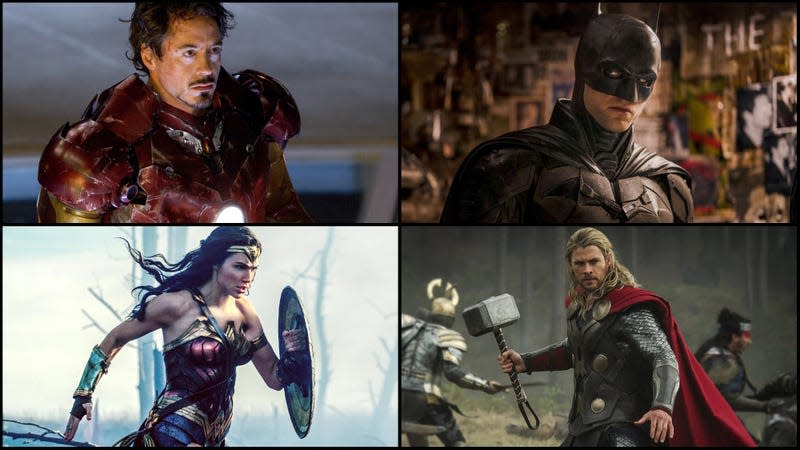
- Oops!Something went wrong.Please try again later.
- Oops!Something went wrong.Please try again later.
Ever since the Marvel Universe was born with the publication of Fantastic Four #1 in 1961, the worlds of Marvel and DC have been evolving in parallel. That has inevitably led to certain mirror images appearing in comics and on screen. Many of those characters underline the various creative and structural links between the two universes, and how that’s shaped the history of superhero fiction as we now know it.
With DC Studios co-head James Gunn recently unveiling his ambitious first chapter of film and TV projects known as “Gods And Monsters,” comparisons between the MCU and DCU will of course keep growing—but where are the strongest character links right now? Let’s take a closer look. From strident defenders of humanity to complex antiheroes, these are the DC and Marvel heroes who match up most closely in their journeys from the comics page to the silver screen.
Read more
Captain America/Superman
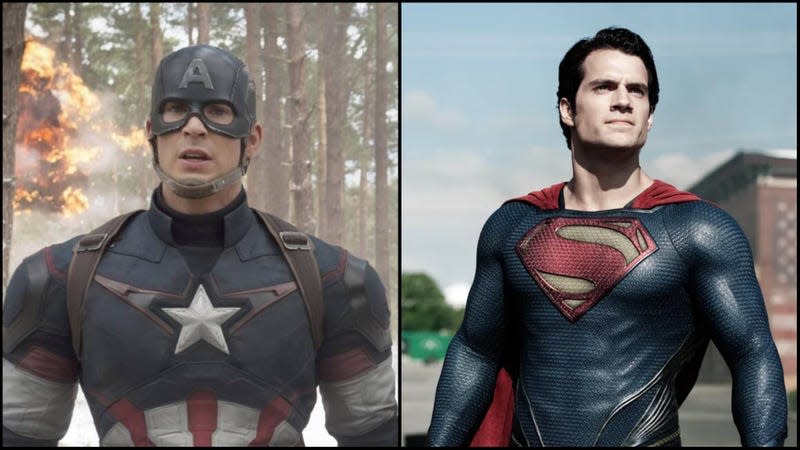
Who Came First: Often recognized as the prototype for all comic book superheroes who came after him, Superman arrived from creators Jerry Siegel and Joe Shuster in the spring of 1938. Captain America arrived from creators Joe Simon and Jack Kirby almost exactly three years later in the spring of 1941, punching Hitler in the face on his very first comics cover.
What They Share: Though their power sets are remarkably different, and they’re technically different species, Superman and Captain America are linked by shared values, shared roles within their respective teams, and a shared sense of working as the moral compass of their respective superhero universes. Though often treated as a living god even within the DCEU, it’s Superman’s humanity which stands out, while Captain America’s status as a “Super Soldier” is never more important than his innate hatred of bullies and sense of steadfastness. Throw in the matching color schemes, and they’re linked by quite a lot.
Iron Man/Batman
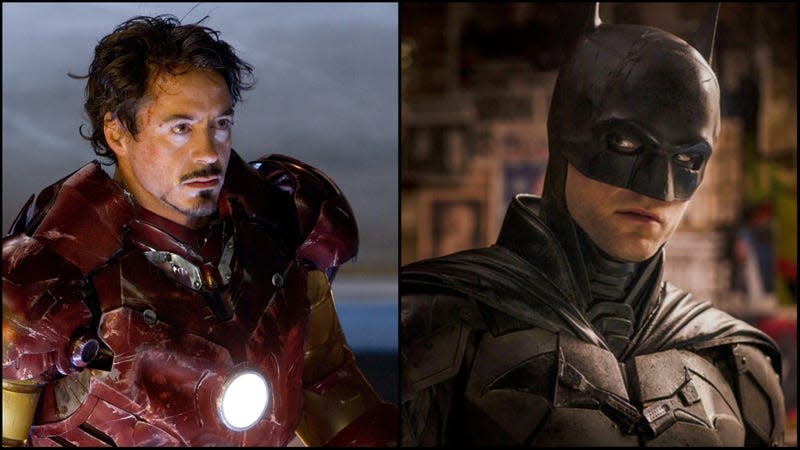
Who Came First: Batman was created by artist Bob Kane and writer Bill Finger in the spring of 1939, one year after the debut of Superman. Iron Man arrived more than 20 years later in 1963, as a collaborative effort between Stan Lee, Jack Kirby, Don Heck, and Larry Lieber.
What They Share: Bruce Wayne and Tony Stark are both billionaire geniuses who use their vast resources to develop superheroic personas which serve as secret identities (for a long time in the comics, “Iron Man” was publicly cast as Tony Stark’s bodyguard, and not Stark himself). In the DCEU and MCU, they both emerge as tortured souls saddled with guilt over how the world around them has taken shape, and both of them eventually use that internal angst to become architects of grand plans for the protection of Earth. Their plans don’t always work, but DCEU Batman and MCU Iron Man both saw something big coming, and both got ready to fight it.
Namor/Aquaman

Who Came First: Created by Bill Everett, Namor debuted in 1939, and remains one of the rare Marvel Comics mainstays to predate the Marvel Universe. Aquaman arrived at DC Comics two years later, from creators Mort Weisinger and Paul Norris.
What They Share: Yes, Namor and Arthur Curry are both the water guys in their universes, and in the comics, they share leadership of the realm of Atlantis. On the big screen, though, they take on certain other shared characteristics. Namor and Arthur are both the products of two worlds, humans whose biology was altered (mutated, in Namor’s case) by the presence of another force. Because of that, and their attachment to their undersea homes, they stand at a certain distance from other Marvel and DC icons, even if they’re willing to collaborate with them. It makes them both a key part of their respective universes and figures who are able to work within sub-universes of their own.
Doctor Strange/Doctor Fate

Who Came First: The original incarnation of Doctor Fate arrived in 1940 from creators Gardner Fox and Howard Sherman, and many other incarnations followed over the years. Doctor Strange emerged early in the formation of the Marvel Universe back in 1963, and was created by Steve Ditko.
What They Share: Apart from the obvious similarities in their names, Strange and Fate are both powerful sorcerers who are the sole wielders of certain key magical artifacts within their comic book universes. On the big screen, Strange has appeared to be more standoffish than Fate, though both share a certain code of magical practice and a great burden of responsibility. Whether we’re talking about Strange looking into the multiverse or Fate seeing premonitions of his friends dying, both heroes have to live with secret knowledge that’s at once helpful and torturous.
Winter Soldier/Deadshot

Who Came First: Though he wouldn’t be the Winter Soldier until Ed Brubaker and Steve Epting brought him back in 2005, Bucky Barnes first emerged in Captain America Comics #1 as a creation of Joe Simon and Jack Kirby in 1941. Deadshot arrived nine years later in DC comics, from creators David Vern Reed, Lew Sayre Schwartz, and Bob Kane.
What They Share: Both Deadshot and the Winter Soldier emerge in their respective universes as impossibly skilled assassins, adept at taking down their targets no matter what and walking in the circles of both heroes and villains as the situation suits them. Those characteristics followed them to the films, and while Deadshot’s big-screen life has certainly been shorter than Winter Soldier’s, the notion of an assassin who can work with villains and then become a hero has lived on in the DCEU thanks to one of Deadshot’s fellow Suicide Squad alums, Bloodsport.
Thor/Wonder Woman

Who Came First: Creator William Moulton Marston debuted Wonder Woman in the fall of 1941, three years after Superman and two years after the arrival of Batman. While Thor has existed for millennia in Norse mythology, the Marvel Comics version landed in the summer of 1962, courtesy of Stan Lee, Larry Lieber, and Jack Kirby.
What They Share: Though they certainly have several key differences, Wonder Woman and Thor share the same role within the respective trinities that form the core of their comic book and big-screen universes. They’re both mythological beings from other worlds who are transplanted into human society and must not only learn to live among people, but learn to appreciate what humankind has to offer the wider cosmos. The fish-out-of-water comedy stylings of both Gal Gadot and Chris Hemsworth have linked them in the films, as has their shared ability to exist on a different timeline than their fellow mortal heroes.
Hulk/Black Adam

Who Came First: Though his origins and behaviors would be revised several times upon his introduction to DC Comics, Black Adam’s first appearance dates all the way back to 1945, when Otto Binder and C.C. Beck introduced him as a Fawcett Comics character. The Incredible Hulk arrived early in the formation of the Marvel Universe, introduced by Stan Lee and Jack Kirby in 1962.
What They Share: Though their comic incarnations are vastly different in appearance and origin, and Bruce Banner and Teth-Adam are very different people, the way these characters have evolved links them in quite a few ways, particularly when we consider the film incarnations. Like the Hulk, Black Adam is driven by rage, and Adam himself must fight to control his own inner rage in managing his powers and behavior, much like Bruce Banner. Through their adventures and lives, both also become entangled in more than one world—Adam through his stewardship of his homeland and Banner through his emergence as a hero of Sakaar—and that creates even greater moral entanglements for future stories to mine.
Quicksilver/The Flash
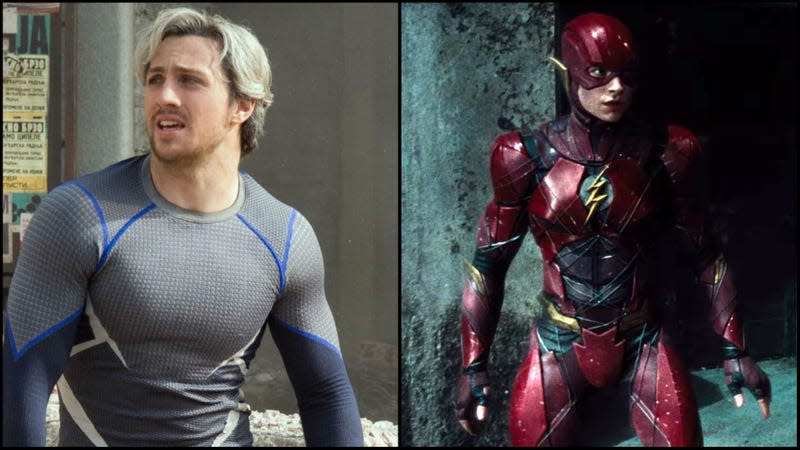
Who Came First: Though the original Flash dates back to the 1940s, the most famous version of the hero, Barry Allen, was created by Robert Kanigher and Carmine Infantino in 1956. Quicksilver emerged at Marvel in 1964, created by Stan Lee and Jack Kirby.
What They Share: Barry Allen and Pietro Maximoff are the two characters in their respective cinematic universes who run really fast. That’s the obvious connection, but over the course of their screen histories, some other interesting connections have emerged. Both share strange extended superhero families, something enhanced by the upcoming Flash film and Pietro’s loose connection to WandaVision, and both are also dialed into the concept of the multiverse, something emphasized both by Barry’s upcoming film and Pietro’s previous appearance in two superhero franchises at the same time.
Captain Marvel/Green Lantern

Who Came First: Though the original Green Lantern dates back to the ’40s, the most famous version of the character landed in 1959, when John Broome and Gil Kane created Hal Jordan. Other heroes have held the Captain Marvel mantle over the years, but the current Captain, Carol Danvers, was created by Roy Thomas and Gene Colan in 1968.
What They Share: Carol Danvers and Hal Jordan are both pilots whose adventures bring them into contact with phenomenal cosmic powers which help to make them guardians of both their home planet and a wider swath of the galaxy. Both characters have interesting relationships with their powers, both must work to be as fearless as possible in order to master them, and both have to constantly balance the needs of Earth with the needs of a wider sector of space. Captain Marvel’s not part of a corps, necessarily, but with The Marvels coming up, she’s definitely got a family of heroes growing around her.
Ant-Man/Atom Smasher

Who Came First: The original Ant-Man, Hank Pym, debuted in Marvel Comics courtesy of Stan Lee, Larry Lieber, and Jack Kirby back in 1962. Though Atom Smasher has family ties all the way back to the original Atom of the 1940s, he didn’t emerge as a hero in his own right until Roy Thomas and Jerry Ordway created him in 1983.
What They Share: Atom Smasher and the various heroes who wear the Ant-Man mantle can shift their molecular structure to change size, though in Atom Smasher’s case, it’s all about getting bigger, something the Ant-Men only do sometimes. In their film appearances, Atom Smasher and Ant-Man Scott Lang both act as comic relief for their respective superhero teams, masking their insecurities about becoming heroes with humor and vulnerability. That makes them valuable audience point-of-view characters, as well as endearing heroes who are still learning how to be good guys.
Thunderbolt Ross/Amanda Waller

Who Came First: Created by Stan Lee and Jack Kirby, Thaddeus “Thunderbolt” Ross first appeared alongside the Incredible Hulk in 1962. Amanda Waller, from creators John Ostrander, Len Wein, and John Byrne, arrived more than two decades later, in 1986.
What They Share: Though Ross emerged with a different motivation back in the 1960s, initially serving as a sworn enemy of the Hulk, he and Waller have developed certain parallel paths over the intervening decades. In their respective cinematic incarnations, both are taskmasters who attempt to bring super-powered beings to heel in an unpredictable world, and both seem willing to cross lines to do just that, even if Waller is a bit more amoral than Ross would seem to be.
Scarlet Witch/Enchantress
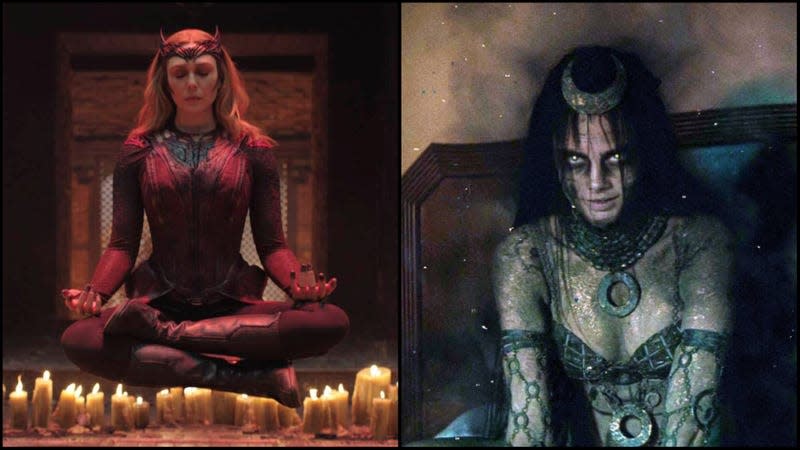
Who Came First: Jack Kirby and Stan Lee debuted the Scarlet Witch at Marvel in 1964, while the Enchantress arrived at DC Comics two years later, from creators Bob Haney and Howard Purcell.
What They Share: Both Wanda Maximoff and June Moone have a dark, often volatile connection with magic, though they came to those connections through different means. In both comics and film, Enchantress is often depicted as a villain who becomes a reluctant hero, while Wanda is a hero who’s often a reluctant antagonist. Apart from their magic, they both share a deep sense of struggle over determining who they really are, as both Wanda and June must try to assert themselves even while living in tandem with the magical personas inhabiting their bodies.
Black Widow/Huntress

Who Came First: Stan Lee, Don Rico, and Don Heck launched Natasha Romanoff in Marvel Comics back in 1964. Though other characters bore the Huntress title before her, the Huntress we know, Helena Bertinelli, first appeared via creators Joey Cavalieri and Joe Staton back in 1989.
What They Share: Though they come to their roles through very different methods and serve in different capacities in their respective universes, both Natasha Romanoff and Helena Bertinelli share quite a bit. They’re both accomplished killers, they’re both morally grey in terms of how far they’re willing to go, and they’re both surprised by how much fulfillment they get out of being part of a team. We’ve only just begun to see Huntress’ big-screen story, but it wouldn’t be surprising if her arc eventually grew just as emotionally dense as Black Widow’s.
Punisher/Peacemaker

Who Came First: Though he wouldn’t emerge as a DC Comics character until the 1980s, Peacemaker first appeared in the pages of Charlton Comics in 1966, created by Joe Gill and Pat Boyette. Punisher arrived at Marvel in 1974 as an enemy of Spider-Man, created by Gerry Conway, John Romita Sr., and Ross Andru.
What They Share: Both Punisher and Peacemaker have evolved over the years, but at their core there’s the sense that they must become killing machines in order to make the world a better place, no matter what the personal cost is to themselves. In the case of the DCEU, this is played a bit more for laughs than Marvel’s screen version of the Punisher, but the moral quandaries and inner turmoil of each character remain intact. Both men have to question what a lifetime of killing does to their respective psyches, and that makes them fascinating.
Vision/Cyborg

Who Came First: One of the most important additions to the first decade of Avengers comics, Vision arrived from creators Roy Thomas and John Buscema in 1968. Cyborg landed in DC Comics as a member of the Teen Titans in 1980, from creators Marv Wolfman and George Perez.
What They Share: There’s an interesting contrast between how Vision and Cyborg arrive at their respective man-machine states. Vision is a synthezoid who has to learn what it means to be human, while Cyborg is a human who has to learn what it means to be part machine. Both struggles eventually bring them to an interesting hybrid reality that’s explored in the films as part of a larger story of how they fit into their respective teams. In both cases, while their powers make them cool, it’s the emotions behind those powers which make them indispensable members of their respective universes.
Thanos/Darkseid

Who Came First: Jack Kirby created Darkseid in 1970 upon moving from Marvel Comics over to DC. Thanos appeared three years later from creator Jim Starlin, who borrowed certain characteristics (namely Darkseid’s stature) from Kirby’s creation.
What They Share: In their respective universes, Thanos and Darkseid are often set up as the ultimate antagonists for teams of superheroes across major event stories, and this sense of ultimate evil coupled with their Space God appearances has linked them forever in the minds of comic book fans. But it’s not just how they’re staged. Though their approaches and personalities are often very different, Thanos and Darkseid are connected by a shared desire for ultimate control over all living things, which makes them both especially driven and especially dangerous.
Deadpool/Deathstroke

Who Came First: Creators Marv Wolfman and George Perez introduced Deathstroke as a Teen Titans villain in 1980. Rob Liefeld and Fabian Nicieza debuted Deadpool in Marvel Comics 11 years later, and the similarities between the characters weren’t lost on them. There’s a reason the character’s name—Wade Wilson and Slade Wilson—rhyme.
What They Share: Obviously both characters are masked killers who have enhanced physiologies and a proficiency with swords, so it’s easy to see what they share visually. Deathstroke and Deadpool also share similar backgrounds, having proven themselves as fighters and eventually becoming mercenaries who underwent experimental procedures to become superhuman. The difference is in the personality, as Deadpool is obviously much more comedically minded, but even beneath that comic facade, there’s a shared emotional pain between the two characters, something more Deathstroke film appearances would eventually be able to expand upon.
More from The A.V. Club
Sign up for The A.V. Club's Newsletter. For the latest news, Facebook, Twitter and Instagram.

